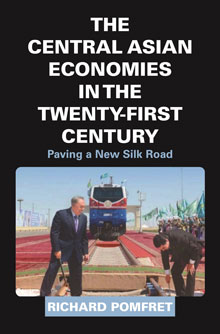Richard Pomfret

The Central Asian
Economies in the
Twenty-First Century:
Paving a New Silk Road
Princeton University Press,
Princeton, NJ, 2019, 328 pp., $45.00
With his previous works, Richard Pomfret has already established himself as one of the leading scholars of the five central Asian economies: Kazakhstan, the Kyrgyz Republic, Tajikistan, Turkmenistan, and Uzbekistan. His new book, The Central Asian Economies in the Twenty-First Century: Paving a New Silk Road , is very timely given the increased interest by policymakers, investors, and scholars in the region since the transition of power in Uzbekistan in 2016 following the death of the country’s long-serving president. The size, location, and recent political and economic reforms in Uzbekistan have had an impact on the rest of central Asia, boosting regional cooperation, cross-border trade, and greater connectivity. Global political dynamics and the growing economic influence of China in this part of the world have also stimulated interest in Pomfret’s book.
Pomfret takes the reader through the economic transitions of these five former Soviet republics—from centrally planned economies to independent states—with different degrees of market systems and openness to trade and investment. He outlines three major economic shocks faced by all central Asian countries starting in 1991: dissolution of the Soviet Union, transition from central planning, and hyperinflation. The book describes the diverse strategies used by these countries in dealing with these shocks, from the open market approach of the Kyrgyz Republic to the slow reform policies of Uzbekistan (until 2017) and the closed economy of Turkmenistan. Pomfret also analyzes the role of natural resources in the economic development of central Asia, with Kazakhstan being the major beneficiary of the oil development of the past two decades.
The book provides a detailed description of the evolution of the political economy of these five countries. Pomfret demonstrates deep knowledge of the economic models and government policies of each country since its independence. The book also analyzes the impact of different external forces on central Asian countries, with particular emphasis on the Russia-led Eurasian Economic Union and the impact of trade and investment ties with China.
A particular focus of the book is the challenges and opportunities of regional cooperation in central Asia. Unfriendly and sometimes tense relations between some countries have restricted opportunities for intraregional trade and infrastructure development. With the significant investments in infrastructure by these countries’ governments and international financial institutions as well as by foreign investors, conditions are favorable to increase regional integration, maximize the transit potential of the region, and restore the historic role of central Asia as the crossroads of the silk roads connecting Asia and Europe. Pomfret expands on this potential in the last chapter of his book, expressing cautious optimism for central Asia to restore its historic influence.
Pomfret’s book would have been stronger if it had focused more on the private sector’s perspective on national and regional economic development models and on the links between foreign direct investment, employment, and hard and soft infrastructure development for better connectivity and trade.
Overall, the book makes a significant contribution to the study of the evolution of the economies of central Asia and to evaluating the potential of these countries to meet the challenges and opportunities of the 21st century.
Opinions expressed in articles and other materials are those of the authors; they do not necessarily reflect IMF policy.








